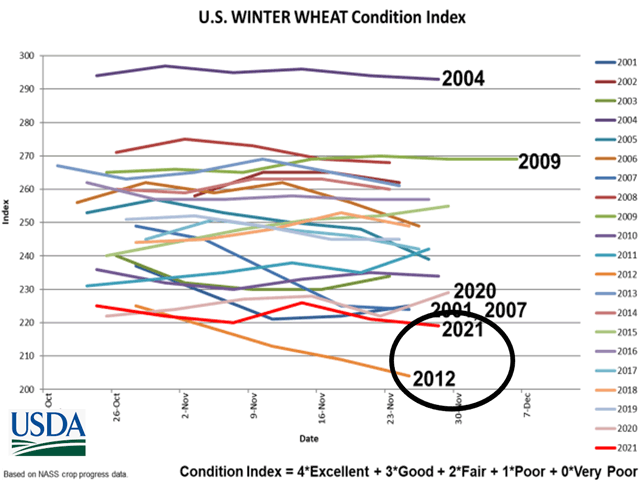Ag Weather Forum
Dry Fall Hits Winter Wheat Rating
There's a long way to go in the production cycle of the 2021-22 U.S. winter wheat crop. However, it's fair to say that the 2021-22 crop is going into dormancy in subpar condition. The last USDA NASS crop progress and condition rating of the calendar year 2021 summarized the situation as follows:
"As the USDA/NASS winter wheat reporting season ended in late November, the wheat condition index was the lowest at that time of year since 2012 -- and the second-lowest of the 21st century to date. Across portions of the Great Plains and Northwest, establishment of the wheat crop has been hampered by lack of topsoil moisture, leaving 23% of the U.S. crop rated in very poor to poor condition."
A brief review of precipitation in the Great Plains and the Northwest shows mainly below-normal amounts for the year. That is no surprise, particularly in northern areas.
Following are some representative totals for the year through Dec. 8:
-- Spokane, Washington: 10.25 inches, 4.47 inches (30%) below normal
-- Pendleton, Oregon: 7.62 inches, 4.09 inches (35%) below normal
-- Glasgow, Montana: 6.15 inches, 6.97 inches (53%) below normal
P[L1] D[0x0] M[300x250] OOP[F] ADUNIT[] T[]
-- Bismarck, North Dakota: 11.49 inches, 7.11 inches (38%) below normal
-- Pierre, South Dakota: 14.06 inches, 5.67 inches (29%) below normal
-- Sidney, Nebraska: 8.43 inches, 7.26 inches (46%) below normal
-- Goodland, Kansas: 13.16 inches, 5.58 inches (30%) below normal
-- Dodge City, Kansas: 19.82 inches, 1.44 inches (7%) below normal
-- Salina, Kansas: 26.03 inches, 2.87 inches (10%) below normal
-- Wichita, Kansas: 30.55 inches, 2.88 inches (9%) below normal
-- Oklahoma City, Oklahoma: 31.42 inches, 3.65 inches (10%) below normal
-- Amarillo, Texas: 15.03 inches, 4.08 inches (21%) below normal
-- Wichita Falls, Texas: 25.52 inches, 1.25 inches (5%) below normal.
Looking ahead into 2022, seasonal forecasts continue to suggest that the Northwest will see above-normal amounts of precipitation through the winter and early spring. This would offer some improvement in soil moisture for winter wheat when it exits dormancy.
The above-normal signal is not as robust for the Northern Plains; however, some areas could receive normal amounts. The Southern Plains, however, has a dominant below-normal indication for precipitation through not only post-dormancy but all the way into Northern Hemisphere summer 2022. If that forecast verifies, winter wheat may struggle with dryness as the crop goes through its jointing, heading and filling stages.
Considering the relatively tight supply situation that wheat has right now, the precipitation during the next six months will certainly merit close attention. U.S. Wheat Associates noted that the United Nations Food and Agriculture Organization, in a biannual report published Dec. 2, said, "The ratio of major wheat exporters' closing stocks to their total disappearance is expected to fall to 12.5%." The report also noted that, if realized, this will be the lowest level in more than two decades.
DTN analysts Mary Kennedy and Cliff Jamieson contributed to the preparation of this post.
Bryce Anderson can be reached at Bryce.anderson@dtn.com
Follow him on Twitter @BAndersonDTN
(c) Copyright 2021 DTN, LLC. All rights reserved.






Comments
To comment, please Log In or Join our Community .